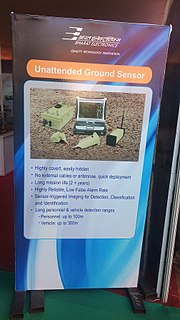Draper Laboratory is an American not-for-profit research and development organization, headquartered in Cambridge, Massachusetts; its official name is "The Charles Stark Draper Laboratory, Inc". The laboratory specializes in the design, development, and deployment of advanced technology solutions to problems in national security, space exploration, health care and energy.
Measurement and signature intelligence (MASINT) is a technical branch of intelligence gathering, which serves to detect, track, identify or describe the distinctive characteristics (signatures) of fixed or dynamic target sources. This often includes radar intelligence, acoustic intelligence, nuclear intelligence, and chemical and biological intelligence. MASINT is defined as scientific and technical intelligence derived from the analysis of data obtained from sensing instruments for the purpose of identifying any distinctive features associated with the source, emitter or sender, to facilitate the latter’s measurement and identification.

Future Combat Systems (FCS) was the United States Army's principal modernization program from 2003 to early 2009. Formally launched in 2003, FCS was envisioned to create new brigades equipped with new manned and unmanned vehicles linked by an unprecedented fast and flexible battlefield network. The U.S. Army claimed it was their "most ambitious and far-reaching modernization" program since World War II. In April and May 2009, Pentagon and army officials announced that the FCS vehicle-development effort would be cancelled. The rest of the FCS effort would be swept into a new, pan-army program called the Army Brigade Combat Team Modernization Program.

The Army Research Laboratory (ARL) is the U.S. Army's corporate research laboratory. ARL is headquartered at the Adelphi Laboratory Center (ALC) in Adelphi, Maryland. Its largest single site is at Aberdeen Proving Ground, Maryland. Other major ARL locations include Research Triangle Park, North Carolina, White Sands Missile Range, New Mexico, Orlando, Florida, and NASA's Glenn Research Center, Ohio and Langley Research Center, Virginia.
Bharat Electronics Limited (BEL) is an Indian state-owned aerospace and defence company with about nine factories, and several regional offices in India.
The FIDO explosives detector is created by ICx Technologies, Inc. and is based on a proprietary technology developed by MIT called amplifying fluorescent polymer (AFP). The AFP technology was invented by Timothy M. Swager and won him the 2007 Lemelson-MIT Prize. It was adapted for use in the FIDO explosives detector to detect trace levels of explosive materials. The product is so named because its level of detection is comparable to highly trained explosives detection dogs, the gold standard in explosives detection technology.

The FCS Network - Brigade Combat Team (BCT) Network consists of five layers that combine to provide seamless delivery of data to forward-deployed Army units.
Geophysical MASINT is a branch of Measurement and Signature Intelligence (MASINT) that involves phenomena transmitted through the earth and manmade structures including emitted or reflected sounds, pressure waves, vibrations, and magnetic field or ionosphere disturbances.

The unattended ground sensor (UGS) is under development as part of the United States Army's Future Combat Systems Program. For information on currently fielded UGS systems, refer to the Current Force UGS Program or CF UGS.
Spectron Glass and Electronics Inc. is an electronics company headquartered in Hauppauge on Long Island, in New York state.

An inertial navigation system (INS) is a navigation device that uses a computer, motion sensors (accelerometers) and rotation sensors (gyroscopes) to continuously calculate by dead reckoning the position, the orientation, and the velocity of a moving object without the need for external references. Often the inertial sensors are supplemented by a barometric altimeter and occasionally by magnetic sensors (magnetometers) and/or speed measuring devices. INSs are used on vehicles such as ships, aircraft, submarines, guided missiles, and spacecraft. Other terms used to refer to inertial navigation systems or closely related devices include inertial guidance system, inertial instrument, inertial measurement unit (IMU) and many other variations. Older INS systems generally used an inertial platform as their mounting point to the vehicle and the terms are sometimes considered synonymous.

The BCT Common controller (CC) serves as a controller for many different BCT unmanned systems.

A Quantum Well Infrared Photodetector (QWIP) is an infrared photodetector, which uses electronic intersubband transitions in quantum wells to absorb photons. In order to be used for infrared detection, the parameters of the quantum wells in the quantum well infrared photodetector are adjusted so that the energy difference between its first and second quantized states match the incoming infrared photon energy. QWIPs are typically made of gallium arsenide, a material commonly found in smartphones and high-speed communications equipment. Depending on the material and the design of the quantum wells, the energy levels of the QWIP can be tailored to absorb radiation in the infrared region from 3 to 20 µm.
Project Scorpion is a multinational military modernization program which uses military-run experimentation for acquisition of new armaments. Project Scorpion also tests new military behaviors such as effects-based operations, network-centric warfare, and irregular warfare and civilian-military concepts.

Counter-IED equipment are created primarily for military and law enforcement. They are used for standoff detection of explosives and explosive precursor components and defeating the Improvised Explosive Devices (IEDs) devices themselves as part of a broader counter-terrorism, counter-insurgency, or law enforcement effort.

Shimmer Sensing is a Dublin based wearable technology company that produces wearable wireless sensors, which can be used to monitor health, athletic performance and biophysical responses. Shimmer's sensing technology allows for simple capture and transmission of biophysical and kinematic data in real-time which can be logged or streamed via Bluetooth to another Bluetooth enabled device like a PC or mobile device. Shimmer's sensors record and transmit a wide range of data related to the person and their external environment. This unlocks the potential for analysis and interpretation of sensed data specific to the person, their application, and their environment.
The Buckeye system is an operational airborne surveying system that provides high-resolution spatial imagery over an area of interest to support military operations involved with intelligence, surveillance, and reconnaissance. Once mounted on a helicopter or an Unmanned Aerial Vehicle (UAV), it incorporates visual information from a digital camera and elevation data from a Light Detection and Ranging (LIDAR) system to create a two and three-dimensional colored map with orthorectified, 4 to 6-inch resolution.
Unattended Transient Acoustic MASINT Sensor (UTAMS)Mortar, Rocket, Explosive Locator System is an acoustic localization sensor system developed by the Sensors and Electronic Devices Directorate (SEDD) of the U.S. Army Research Laboratory (ARL) in 2004. This technology is utilized to detect and isolate transient events such as mortar or rocket firings, munition impacts, and other explosive events. It consists of an array of acoustic sensor stations that are linked via radio to a receiving base. Each sensor has the ability to monitor hostile territory, international borders, and/or detect indirect weapon fire covertly with 24-hour surveillance. These small, inexpensive, non-imaging sensors can monitor large areas without a significant need for power sources and manpower.
The Agentase Chemical Agent Detection (CAD) Kit, formerly known as the Fido C1 CAD Kit, is an enzyme-based chemical detection kit that contains six different sensors that are designed to detect specific chemical warfare agents (CWAs) and other toxic chemical contaminants at trace levels. The kit is provided in a small pouch and can detect the presence of the chemical agents within five minutes.









